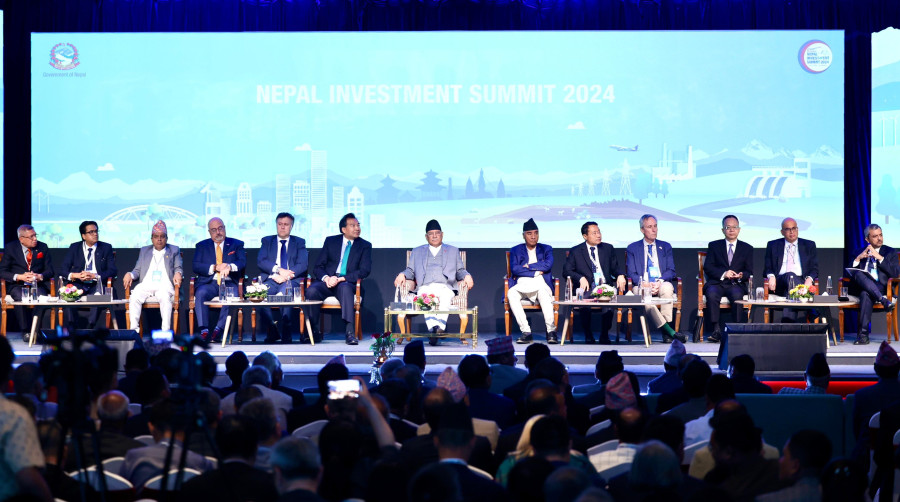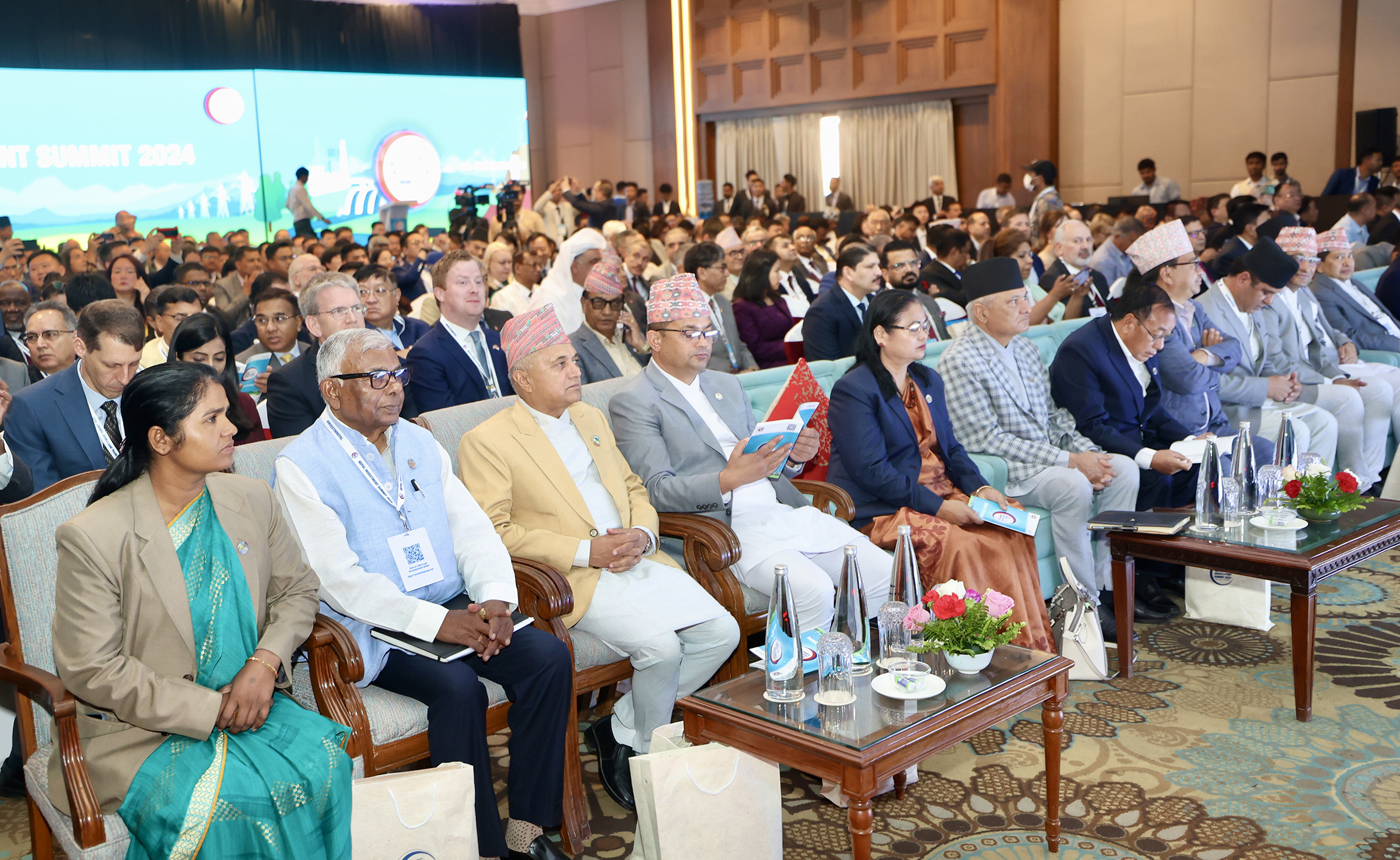Money
Neighbours India and China make tall promises at Nepal Investment Summit
Beijing plans to open flights to Pokhara and Bhairahawa airports, announces visa fee exemption for Nepali travellers.
Sangam Prasain
China on Sunday announced exempting visa fees for Nepali travellers starting May 1 and launching of commercial flights to Nepal’s two new international airports, which are marred by geopolitics, under Beijing's renewed economic diplomacy for Nepal.
India, on the other hand, said it would make Nepal prosperous through hydro energy trade.
Speaking at the third Nepal Investment Summit in Nepal’s capital Kathmandu, Luo Zhaohui, the chairman of China International Development Cooperation Agency (CIDCA), said the Chinese government will continue to attach great importance to direct and indirect investment in Nepal to implement the Trans-Himalaya dimensional connectivity, which is the highest priority for countries.
“Air and road links and border checkpoints are going well. Feasibility studies of the cross-border railway and cross-border transmission lines are moving forward,” he said. “That’s why, today’s summit is of very special significance.”
The Chinese government is making arrangements to start new flights from China to Nepal’s two new international airports—Pokhara and Lumbini. “In this regard, I have good news to share with you that from May 1, or after three days, there will be no visa fee for the Nepali people to [visit] China,” said Luo.
Nepal's $216 million international airport in Pokhara, the country's tourism capital, funded by Beijing, opened in January last year.
Similarly, Nepal's second international airport in Bhairahawa, built by Chinese contractors, started its operation in May 2022 after four years of construction delays. The objective of both projects is to decentralise economic activities in the new federal setup, to bring in more tourists, and stop Nepalis from going abroad.
But no single international flight is operating in the two new shiny airports, which critics say is due to the air route issue, which India is reluctant to provide to Nepal. Without entry routes from the southwestern points, these airports have higher operating costs for any airlines entering Nepal from the west. Nepal has been prodding New Delhi for over a decade to open new air corridors but to no avail.
The air route issue, however, does not affect Chinese airlines as they enter and exit Nepal from the northern and eastern border points of Nepal.
Luo said that one of the major achievements between the two neighbours is the agreement to build the Trans Himalaya All-dimensional Connectivity Network. “Last September, Nepal’s Prime Minister Pushpa Kamal Dahal paid an official visit to China. Our leaders have reached an important consensus guiding our future cooperation. All these fruits are in the process of implementation.”
“I’m satisfied to note that more than 350 entrepreneurs from China participated in today's function. It shows how the Chinese government and Chinese entrepreneurs show their strong interest in Nepal.”
One of the important policies the Chinese entrepreneurs are quite interested in is to have a bilateral free trade agreement (FTA) arrangements between the two countries, he said.
An FTA reduces barriers to imports and exports between countries by eliminating all or most tariffs, quotas, subsidies, and prohibitions.
“That will be a key to improving Nepal’s investment environment to attract more Chinese investment,” said Luo ending his speech with a Chinese saying, “Build a good nest to attract the phoenix.”
The third edition of the Nepal Investment Summit brought together more than 1,100 foreign participants in Nepal’s capital, Kathmandu, mostly from two immediate neighbours India and China.
To mark the beginning of the summit, the Investment Board Nepal, on Sunday, invited Expressions of Interest (EOI) for 12 projects from potential investors.
The government has offered 148 potential projects, with nearly Rs900 billion worth of ready-to-go projects, to foreign and domestic investors. Most projects, according to the Investment Board Nepal, are related to hydropower, and officials are hopeful that the sector will attract investment from energy-hungry India.
While China claimed that it currently is the top source of FDI for Nepal, India said it has the highest FDI stock in Nepal.
Naveen Srivastava, ambassador of India to Nepal, said India currently is the biggest cumulative FDI investor in Nepal, with more than 33 percent of Nepal's FDI stock, which amounts to about Rs89 billion.
“This investment trend continues its positive trajectory, and in recent times, we've seen new investments coming in sectors such as construction, automobiles, or FMCG [fast-moving consumer goods]. This is apart from the huge investment that India and Indian companies are making in the hydropower sector. As we look to the future, the government of India will continue to encourage Indian industry to invest further in Nepal.”
“The large presence of the Indian delegation today is a reflection of that commitment. We would also be launching a new investment guide for investment by Indian companies in Nepal in collaboration with the Nepal India Chambers of Commerce and Industry,” he said.
“We've launched cross-border digital payments to facilitate an ever greater number of Indian tourists coming to Nepal. Indian tourists already constitute the largest number of foreign visitors to Nepal. In the last few years, hydropower exports from Nepal to India have added a new dimension to our ties. Last year alone, Nepal exported about 650 MW of power to India, earning a considerable revenue, which constituted about 10 percent of Nepal's total export to India or 7 percent of Nepal's global exports.”
To further foster this, Nepal and India have also concluded a long-term agreement on power trade.
“At present, we are also discussing a trilateral power trade between India, Nepal and Bangladesh. The vast demand for clean energy in South Asia with a combined population of close to two billion people provides an opportunity for Nepal to further boost its hydropower potential and economic development,” said Srivastava.
In his video messages, Piyush Goyal, India’s Minister of Commerce and Industry, said Nepal is a key partner in India's Neighbourhood First policy. “We will continue to invest in Nepal. We will continue to expand our trading and business relationship.” “I urge Indian investors across the globe to invest in Nepal, to seize the opportunity, and become a part of emerging Nepal.”
Sushil Sharma, chairman and managing director of SJVN Limited, an India-based company engaged in the power generation, said SJVN started its journey in Nepal in 2008 by signing a memorandum of understanding for the 900 MW Arun III Hydroelectric Project. “And since then, we have moved a long way developing three hydro projects of around 2,000 MW, which are under different stages of implementation.”
He said that the enactment of the Public-Private Partnership and Investment Act in 2019 was one such major initiative of Nepal. “The expeditious clearance of Lower Arun detailed project report [DPR] in a record time of 90 days, which has not happened in India itself.”

SJVN Limited is developing 57 gigawatts of power projects in the fields of hydro, solar, wind, thermal energy, and out of these, 2,200 MW are hydropower projects in Nepal, and investments of more than Rs330 billion will be drawn to implement the Nepal-based projects, said Sharma.
“I would like to highlight that SJVN is committed to generating more than 5,000 MW of hydropower in Nepal by 2030,” he said.
“India has signed an agreement for importing 10,000 MW of electricity from Nepal. However, we know the electricity market has now converted from a seller's market into a buyer's market, especially concerning India. Therefore, the development of hydro projects in Nepal requires time-bound and cost-effective completion so that the power generated in Nepal remains competitive in the export market,” said Sharma.
“I would also like to draw the attention of the government on their part towards areas where improvement is still required, especially laws regarding the acquisition of private and forest land for timely completion of ongoing projects.
“As such, all necessary regulations in transmission infrastructure need to be framed at the earliest to achieve this ambitious target for which, the government of Nepal is humbly requested to delegate more powers to the Investment Board Nepal.”
Prime Minister Pushpa Kamal Dahal inaugurated the two-day summit.
In his remarks, Dahal said that Nepal provides several incentives to foreign investors, including a robust regulatory framework, provision for the avoidance of double taxation, protection of intellectual property rights, and competitive corporate taxation, among others, and urged foreigners to invest in Nepal.
“Nepal has recently approved the Bilateral Investment Agreement (BIA) framework, which aims to protect and promote bilateral investment. I encourage all our friendly nations to consider signing the BIA at the earliest.”
The prime minister said that the skilled workforce and low labour costs make Nepal an attractive proposition for international investors. “Provisions of national and non-discriminatory treatment for all FDIs and guaranteed repatriation in foreign currency further enhance the attractiveness of investing in Nepal.”
Finance Minister Barsha Man Pun said the main objective of the summit is to project Nepal as an emerging destination for private sector investment and to highlight recent reforms in enhancing the investment climate and ensuring regulatory frameworks that support foreign as well as domestic investment.
“To improve the business environment and boost investors' confidence, we have initiated various policy reforms. These reforms include improving regulatory processes, reducing the time and cost of business, and ensuring transparency and accountability in public sector governance. Reform is an ongoing process, it will be continued in the days to come,” said Pun.
President of the Nepali Congress and former prime minister Sher Bahadur Deuba said, “Nepal is still a least developed country. We confront huge development challenges. While our country has huge potential for development, we lack adequate capital and appropriate technology to realise development benefits. In this context, the convening of this high-level event assumes a particular significance.”
Deuba said that flexible labour laws, a demographic dividend with a substantial share of the young and energetic population, a reliable supply of electricity, and the availability of local raw materials also contribute to making production costs low compared to other high-wage countries in the region.
“Moreover, all major political parties remain committed to promoting foreign investment in Nepal and come together to foster consensus on key investment-related issues. We do not pursue discriminatory policies towards foreign investors. They are treated on par with national investors. We welcome foreign investors as our valued guests.”
Atul Keshap, senior vice president for South Asia at the United States Chamber of Commerce, said that the commitment made by Nepal to lasting reforms would enable the country’s business environment and private sector to truly flourish and generate sustainable, inclusive, and resilient growth for Nepal’s citizens.
“This Investment Summit presents the opportunity to further enact economic reforms that will truly open Nepal to global markets and world-leading businesses. Creating a more level playing field for foreign companies, building regulatory predictability and mechanisms for stakeholder inputs, and focusing on ease of doing business will generate further investment interest in Nepal.”
President of the Federation of Nepalese Chambers of Commerce and Industry (FNCCI) Chandra Prasad Dhakal urged investors from around the world to seize the opportunity and invest in Nepal's burgeoning economy.
Dhakal highlighted Nepal's strategic location between the economic powerhouses China and India, underscoring its significance as a gateway to vast markets. He emphasised the abundant opportunities across various sectors, including tourism, infrastructure, energy, agriculture, technology, and ICT.




 10.12°C Kathmandu
10.12°C Kathmandu














